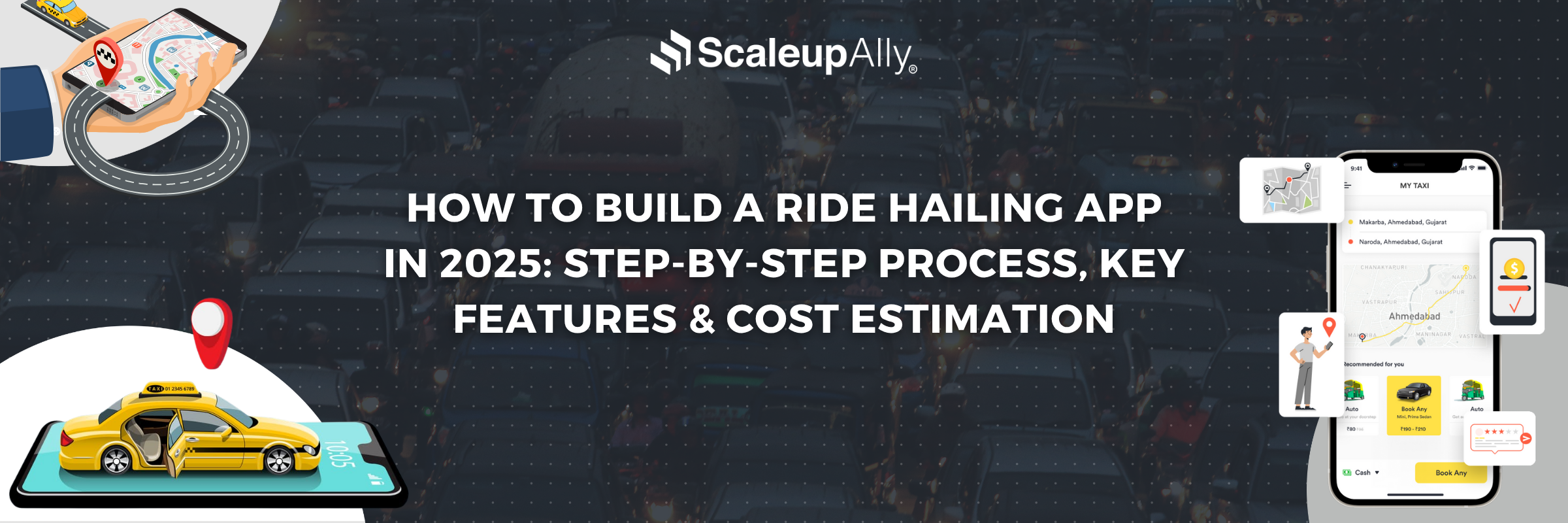
How to Build a Ride Hailing App in 2025: Step-by-Step Process, Key Features & Cost Estimation
Suprabhat Sen | July 31, 2025 , 12 min read
Table Of Content
Ride hailing app development has become more accessible than ever. There are new tools, better frameworks, and clearer roadmaps to get started.
This guide discusses must-have features, the cost of development, steps involved in developing a ride hailing app, and many more.
Key Takeaways
- When developing a ride hailing app, focus on essential features first. What matters is real-time tracking, multiple payments, and driver earnings dashboards.
- Expect to spend between $100,000-500,000 for development. Also, budget for ongoing costs that grow with your user base, like cloud storage.
- A challenge you might face while developing a ride hailing app is the chicken-and-egg problem of getting both drivers and passengers. You also have complex regulations and safety concerns to worry about.
- Ride hailing will hit $344.4 billion by 2030. There’s plenty of room for new players in underserved areas.
Ride Hailing Market Overview & Growth Potential (2025)
By 2030, the global market for ride hailing will hit $344.4 billion. This surge is driven by demand. People want convenience. If you think carefully about it, car ownership feels expensive and complicated. Ride hailing solves this problem.
It is reported that ride hailing users will reach 2.1 billion by 2028. That’s nearly double today’s user base. Revenue per user keeps climbing too. It’s going up from $80.7 in 2017 to a projected $92.29 by 2029.
Despite the numbers, the market isn’t saturated. Uber and Lyft may dominate in some regions, but gaps exist everywhere. For example, rural areas need better coverage and specialized services, like medical transport or luxury rides.
The technology barrier has dropped as well. Cloud platforms make scaling easier, and GPS accuracy has improved. A crucial part of the app (payment systems) works seamlessly across devices. What once required massive upfront investment now costs a fraction.
You don’t need to compete with Uber globally at the moment. You can solve local problems by building for specific niches and creating better experiences for underserved communities.
The business model works. Revenue is generated through commissions, surge pricing, and subscription services. Multiple revenue streams mean stability.
Ride-hailing app development is one of the clear paths to recurring revenue. Users need transportation daily. They’ll pay for reliability and convenience.
Must-Have Features for a Ride-Hailing App
Your ride hailing app needs the right features to succeed. Below are a few must-have features of a successful ride hailing app:
Must-Have Features for Passengers

- Include Real-time tracking to show exactly where the driver is. Users do not need to stand on street corners wondering if a ride is coming or not.
- Provide multiple payment options by giving users the choice of choosing between credit cards, digital wallets, and cash when making a payment. Some prefer Apple Pay, and others may want to pay cash. So, cover all bases.
- Trip history lets passengers track spending. Business travelers love this for expense reports.
- Driver ratings and reviews build trust among users. Passengers will feel safer when they see driver feedback from other users.
- Fare estimation prevents surprises. Show costs upfront. Include surge pricing too.
- Multiple vehicle options serve different needs. Economy for daily commutes, premium for special occasions, and larger vehicles for groups.
Must-Have Features for Drivers
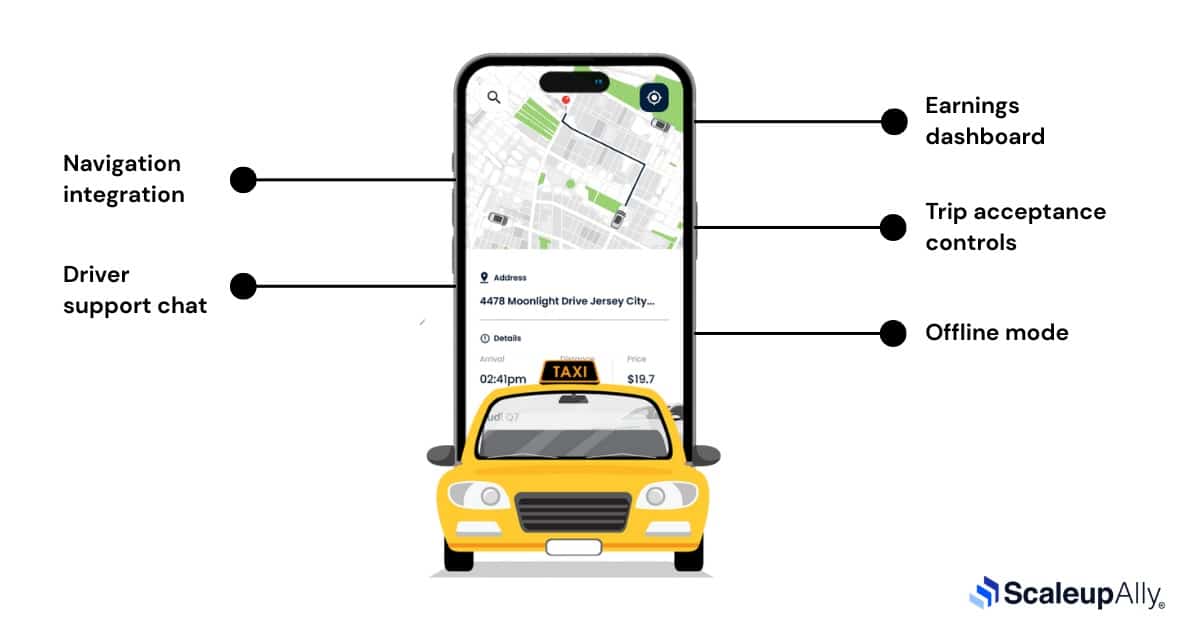
- Earnings dashboard to show daily, weekly, and monthly income. Drivers would want to track their progress easily.
- Navigation integration with traffic updates. This feature will save time and fuel. Every minute matters when you’re paid per ride.
- Trip acceptance controls let drivers choose rides strategically by seeing pickup location, destination, and estimated earnings before accepting.
- Driver support chat resolves issues quickly. When problems arise, drivers should be able to easily contact support for help.
- Offline mode will enable drivers to work without perfect internet. Rural areas have spotty coverage.
8 Steps to Develop a Ride-Hailing App

Here’s a ride hailing app development path from idea to launch:
1. Market Research & Competition Analysis
Before anything else, study your local market first. See which apps are already in operation, what they do so well, and more importantly, what gaps exist in the market. Talk to potential users by interviewing drivers and passengers. Ask about their biggest frustrations with current services. This research will prevent you from making costly mistakes, and shape your entire app.
2. Define Your Business Model
Commission-based is the standard. Ride hailing apps charge between 15-25% of each ride. But consider alternatives like subscription models for frequent users, and surge pricing during peak hours to boost revenue. Advertising and partnerships with local businesses all generate income. Map out how you will make money early.
3. Create Technical Architecture
Decide on your tech stack. Native apps perform better but cost more. Cross-platform frameworks like React Native save development time. Choose decisively.
4. Design User Experience (UX/UI)
Users should be able to book rides in under 30 seconds on the app. Drivers also need to accept trips with one tap. That’s the idea. Keep it in mind when designing. Create wireframes first, then test them with real users. Based on feedback, go ahead and iterate. Pretty designs mean nothing if they confuse users.
5. Develop Core Features
Build an MVP first by developing the essential features. The core features are registration, ride booking, payment processing, and tracking. Get these working perfectly before adding extras. You can release features incrementally after. This lets you test and improve continuously.
6. Integrate Third-Party Services
Maps are an important part of ride hailing apps. Luckily, Google Maps works well, but costs money at scale. Consider alternatives like Mapbox for better pricing.
Payment gateways are important integrations as well. Stripe and PayPal are popular choices. You may also need SMS services to send ride confirmations and updates.
7. Test Thoroughly
Before you launch your app to the general public, ensure it works as it is intended. Test with real users in controlled environments by starting with friends and family, then expanding to a small group of drivers and passengers. Test edge cases too like what happens when GPS fails or how the app handles poor internet. These scenarios break apps in real-world use.
8. Launch & Scale
Soft launch in one city first, and monitor everything including user feedback, server performance, and driver earnings. If you find issues, fix them before expanding.
Marketing matters as much as development. You need both drivers and passengers to create a working marketplace. Incentivize early adopters with bonuses and discounts.
Cost Breakdown of Ride-Hailing App Development
In app developmen, if you don’t budget right, your project will stall halfway through. To help budget well, here’s what you’ll spend:
1. Development Team Costs
Your biggest expense is talent. A basic ride hailing app needs at least six specialists.
- Backend developers charges $50-150 per hour depending on where you hire them. You’ll need two for 6-8 months. That’s about $60,000-180,000 for server-side work.
- Mobile developers charge similar rates. You’ll need separate developers for iOS and Android unless you choose cross-platform development. Expect $80,000-200,000 for both platforms.
- Good UI/UX designers cost $40-100 per hour. Budget $15,000-40,000 for design work.
- You also need a project manager who will keep everything on track. They cost $60-120 per hour.
- Quality assurance testers are also necessary to catch bugs. Budget $20,000-50,000 for thorough testing.
2. Technology Infrastructure
- AWS or Google Cloud starts around $500 monthly. However, your cost will scale as your user base grows. Expect $5,000-20,000 in your first year.
- Third-party services like Google Maps cost $2 per 1,000 requests. Payment processing takes 2.9% plus 30 cents per transaction. If you integrate SMS notifications, it will cost around $0.01-0.05 per message.
- Budget $1,000-5,000 monthly for location services.
3. Feature Complexity Impact
- Basic apps with core features cost $80,000-150,000. This includes registration, booking, tracking, and payments.
- Advanced features multiply costs. In-app chat adds $10,000-20,000. Multi-vehicle options cost another $15,000-30,000. Advanced analytics and reporting systems need $20,000-40,000.
- AI-powered features like demand prediction or route optimization start at $50,000. They’re worth it for competitive advantage.
4. Geographic Considerations
- US-based teams cost $150,000-500,000 for a complete app. Eastern European developers charge $80,000-200,000 for similar quality.
- Indian development teams offer the most economical costs at $40,000-120,000 total.
5. Ongoing Expenses
- Launch isn’t the end. Monthly maintenance costs 15-20% of initial development. A $200,000 app needs $30,000-40,000 yearly for updates and bug fixes.
- Server costs grow with users too. Plan for $2,000-10,000 monthly as you scale.
Total Investment Range
- Minimum viable product: $100,000-200,000
- Full-featured app: $200,000-500,000
- Enterprise-level platform: $500,000-1,000,000+
These estimates are of the assumption that development time will take 6-12 months.
Challenges in Developing a Ride-Hailing App
Ride hailing app development looks simple from the outside. Tap a button, get a ride. Simple right? The truth is, there are a whole lot of complexities behind the scenes. Every successful app overcame these obstacles in one way or the other. Here’s what you’re up against:
1. The Chicken-and-Egg Problem
Passengers won’t use your app without drivers, and drivers won’t join without passengers. These are the facts you have to deal with. Uber solved this by paying drivers hourly rates initially. They guaranteed income while building passenger demand. Their style is expensive, but it worked.
You’ll need similar tactics. It’ll cost money for driver sign-up bonuses, guaranteed earnings, and passenger discounts. Budget heavily for launch incentives.
2. Real-Time Coordination Complexity
Matching riders with drivers sounds easy, but it’s not technically. Your system must process thousands of variables instantly.
Driver location changes every second, and multiple passengers might want the same driver. Your algorithm needs to optimize for these, including distance, wait time, and driver earnings simultaneously. GPS accuracy varies by device and location so your app must handle these gracefully.
3. Regulatory Compliance
Every city has different rules. Some require special licenses. Others mandate insurance minimums. A few ban ride sharing entirely. These are some of the hurdles you will face.
When it comes to legal costs, expect $50,000-200,000 yearly for compliance across multiple cities.
4. Technical Scale Challenges
Your app seems fine with 100 users. But at 10,000 simultaneous users, things may begin to break. For example, push notifications will get delayed. Netflix and Uber both crashed repeatedly during growth phases.
5. Safety and Security Concerns
Every ride involves strangers meeting in private vehicles. Incidents happen. Your app becomes legally responsible in these situations.
You’ll have to do background checks on drivers, but that isn’t foolproof. Emergency features on the app will need instant response. Bad actors target ride hailing platforms specifically.
One serious incident can destroy your brand. Safety features aren’t optional.
6. Driver Retention Struggles
Most drivers quit within six months. They realize earnings don’t meet their expectations. It is unfortunate, but high turnover kills service quality. Successful platforms invest heavily in driver satisfaction. Better support, transparent earnings, and flexible scheduling all cost money but improve retention.
7. Payment Processing Complications
Handling money creates endless headaches like credit card fraud, chargeback disputes, and international payments. Tax reporting also becomes complex across jurisdictions. Financial regulations vary by country.
8. Data Privacy and Compliance
You’re collecting sensitive data constantly like location tracking, payment information, and personal details. These all require protection.
GDPR in Europe, CCPA in California, and dozens of other privacy laws create compliance nightmares. One data breach can cost millions in fines.
How ScaleupAlly Can Help
ScaleupAlly brings expertise and experience to the table for ride hailing app development. We’ve built transportation platforms that scale.
We deliver faster than in-house teams. Our team has handled numerous projects that contained complex real-time tracking, payment integration, and driver-passenger matching algorithms. We know the technical challenges that kill projects. Our developers have solved these problems before. We avoid expensive mistakes.
Ready to build your ride hailing app? Let’s discuss your vision and create something users want. We’ve got it covered.
Conclusion
To build a successful ride hailing app, you must plan, budget, and choose the right development partner. Building an app comes with so many challenges and costs. You cannot gamble it away by choosing the wrong partner.
Turn your vision into reality by contacting ScaleupAlly today. Let’s build your ride hailing platform the smart way.
Frequently Asked Questions
Q: How long does it take to launch a ride-hailing app?
A complete ride hailing app takes 6-12 months to develop. An MVP reduces timeline to 4-6 months.
Q: What tech stack is used in ride-hailing app development?
Popular choices include React Native or Flutter for mobile apps. Node.js or Python for backend. PostgreSQL for databases. AWS for cloud hosting. Google Maps handles location services.
Q: Are ride-hailing apps profitable?
Yes, when executed properly. Successful apps generate revenue through commissions (15-25%), surge pricing, subscriptions, and partnerships. Profitability typically comes after reaching sufficient scale in target markets.
Related Blogs
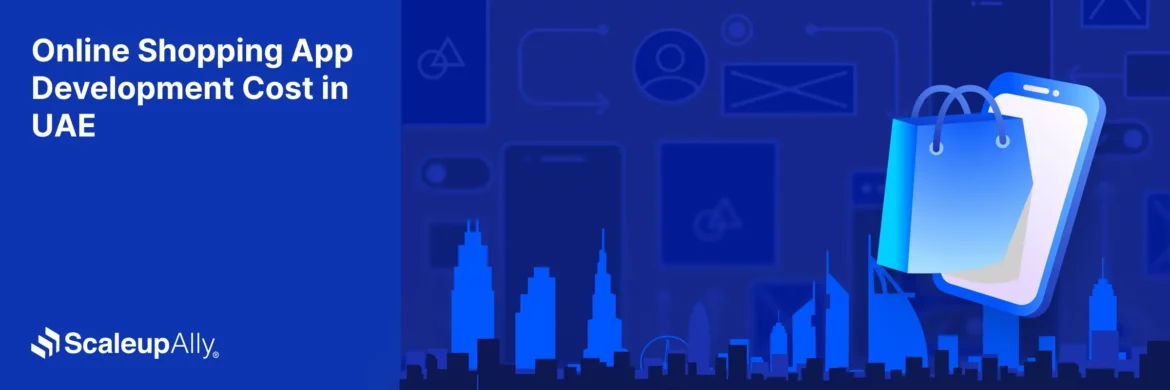
Online Shopping App Development Cost in UAE | Pricing & Factors Explained
Understand UAE online shopping app development costs in 2025 with pricing ranges, influencing factors, hidden fees, timeframes, and expert savings tips.
Suprabhat Sen
Nov 29 ,
13 min read
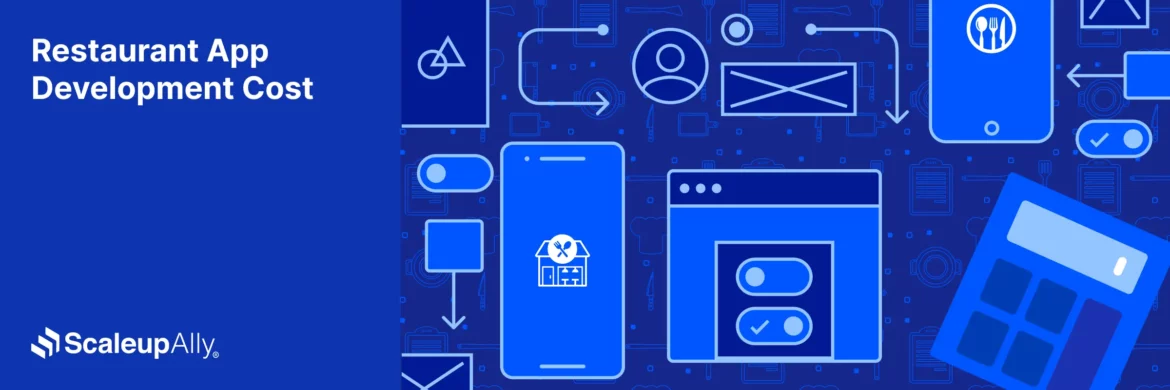
Restaurant App Development Cost [Breakdown, Key Factors & Pricing Explained]
Discover restaurant app development cost. Explore pricing by complexity, feature-wise cost breakdown, and smart ways to reduce expenses.
Suprabhat Sen
Nov 29 ,
11 min read
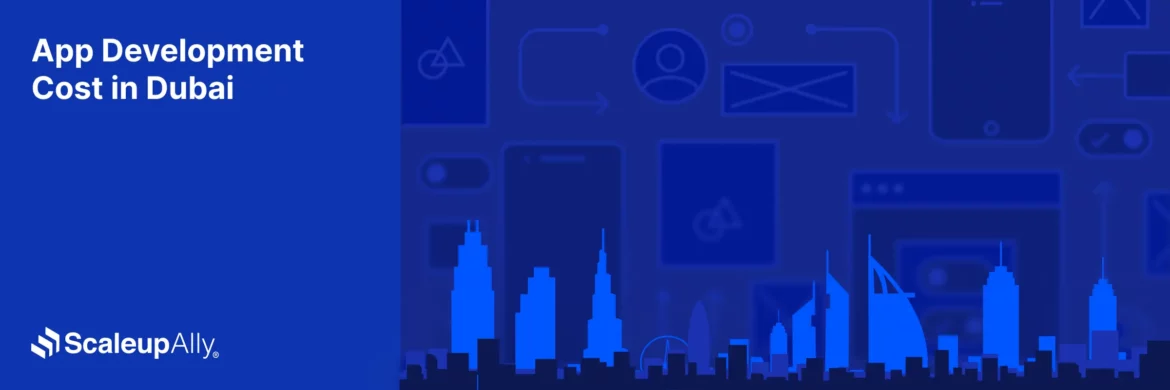
App Development Cost in Dubai: Detailed Pricing Breakdown & Cost Factors
Discover app development cost in Dubai — staged price breakdown by app type, key cost drivers, hidden fees, and tips to lower your project spend.
Suprabhat Sen
Nov 29 ,
12 min read


